Last updated: May 24, 2017
Article
Vessels Disturb Kittlitz’s Murrelets in Glacier Bay National Park and Preserve
By Alison M. Agness
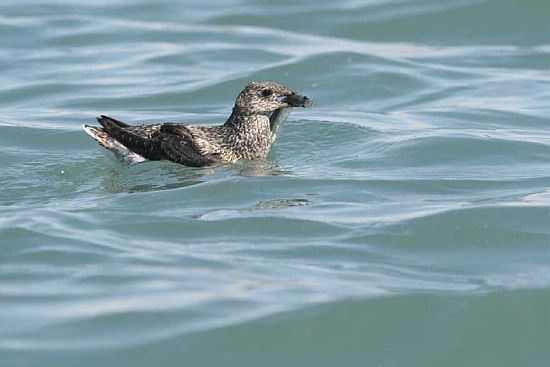
NPS Photo
Abstract
The Kittlitz’s murrelet is a candidate species for listing under the Endangered Species Act that has dramatically declined over the past three decades across its range. Glacier Bay National Park and Preserve supports a large portion of the world population of Kittlitz’s murrelets during their summer breeding season. Although not a likely cause for the species decline, vessel disturbance contributes to the list of threats that currently face Kittlitz’s murrelets. Research results indicate that vessels in Glacier Bay National Park and Preserve, including cruise ships, temporarily displace these birds and disrupt their behavior at energetic expense.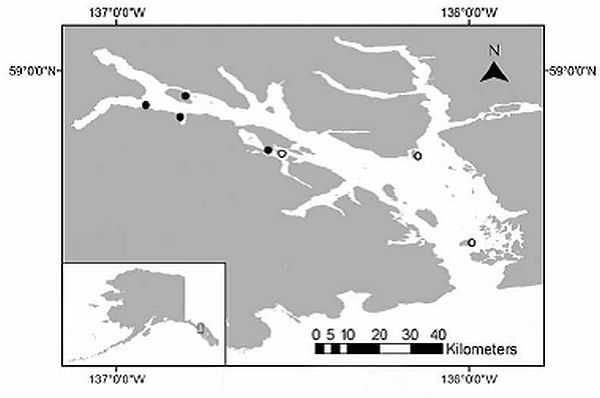
From Agness et al. 2008
Introduction
The Kittlitz’s murrelet is a rare seabird that spends most of its time at sea (Day et al. 1999). The species is a candidate for listing under the Endangered Species Act because of dramatic population declines documented over the past three decades across the species range including in Southeast Alaska (Kuletz et al. 2003). Possible causes for the species decline include oil pollution, fisheries bycatch, food limitations, and global climate change (Day et al. 1999, Kuletz et al. 2003).Although not a likely cause for the species decline, vessel disturbance contributes to the threats that currently face Kittlitz’s murrelets (Agness et al. 2008, Agness et al. in prep). Glacier Bay National Park and Preserve (GLBA) supports a large portion of the world population of Kittlitz’s murrelets during their summer breeding season, where there is a high potential for vessel disturbance of these birds. Marine waters close to tidewater glaciers and the outflow of glacial streams are preferred foraging areas for Kittlitz’s murrelets (i.e., Day et al. 2003), and these same glaciers are the primary draw for tourists and vessel activity in Glacier Bay.
Vessel traffic in Glacier Bay is regulated by the National Park Service to protect sensitive wildlife, and provide for visitor access and wilderness experience. Daily vessel quotas during the summer and vessel operating requirements, such as adherence to speed and area restrictions, are examples of the current vessel regulations in GLBA. The park’s vessel management plan allows for future changes to daily quotas and operating requirements as necessary to protect the values and purpose of the park. The intent of our research was to learn about a little known species, the Kittliz’s murrelet, investigate their interactions with vessels including cruise ships and by doing so, inform vessel management decisions in the park and elsewhere in Alaska.
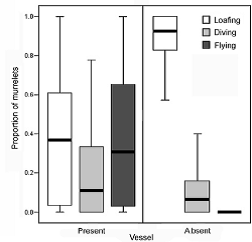
From Agness et al. 2008
Methods
A small field crew observed Kittlitz’s murrelet density and behavior with standard techniques called area-scan and focal bird sampling to collect time-elapsed as well as instantaneous data on the birds at sea. Observations were made at seven sites where Kittlitz’s murrelets occur in Glacier Bay, and sampling took place across daylight hours on regular intervals (Figure 1). Data were collected in the presence and absence of vessels. Sampling took note of opportunistic vessel events as well as a variety of environmental and habitat variables that may affect Kittlitz’s murrelet behavior and presence, such as data on the tides and currents, weather, and time of day. When a vessel came through a study site, observers recorded the vessel size and speed, as well as behavioral response data for proximate Kittlitz’s murrelets. Distance between the vessel and bird was also recorded at the point of behavioral response or at the closest point of approach, in the event that a bird did not respond.The bird behaviors typical of Kittlitz’s murrelets at sea that were recorded included loafing, diving, flying, fish-holding, and flying while holding a fish. Fish-holding behavior is indicative of breeding murrelets that are actively rearing a chick (Carter and Sealy 1987), and observers distinguished birds engaged in this behavior as breeding birds (Figure 1). It is not possible to tell the breeding status of murrelets that are not holding a fish, but for sake of distinction those not holding a fish were labeled non-breeders. An additional behavior, diving while holding a fish, which is not typical for Kittlitz’s murrelets, was a recorded behavior in response to proximate vessels.
Statistical techniques were used to measure a variety of vessel effects on Kittlitz’s murrelets and determine if the effects were immediate, short term (after 30 minutes), or long term (over a day). Modeling techniques were used to assess whether a bird’s flight response from vessels could pose the risk of a fitness effect, or make it more difficult for the bird to successfully reproduce and survive. Potential fitness effects were evaluated as proportional increases in daily energy costs, from >0% to as high as a 50% increase, and also considered if the energy costs are chronic (i.e., occur on most days) or seldomly incurred (i.e., on very few days).
Results
Effects on DensityThe density of Kittlitz’s murrelets decreased in the short term, or 30 minutes after a vessel event, by an average of 40%. Over the course of a day, their density is more affected by environmental and biological variables than by vessels. Kittlitz’s murrelet density was positively correlated with vessel traffic (higher density on days with higher rates of vessel traffic), for reasons that remain unclear. However, this result corroborates that short term decreases in density do not persist for very long.
Effects on Behavior
Vessels caused an immediate increase in flight response, from 0% of birds engaged in flight in the absence of vessels to 30% of birds engaged in flight in the immediate presence of vessels (Figure 2). Additionally, Kittlitz’s murrelets dove three times more on days with vessel activity than on days without vessel activity, even though dive response overall did not significantly change during vessel events, with the exception of breeding birds described below.
Breeding birds were most likely to dive in response to vessels, which is not typical for fish-holders and was not observed in the absence of vessels. 95% of breeding birds dove in response to fast moving (> 10 miles/hr) vessels, regardless of vessel size or approach distance. Breeding birds also responded to vessels by flying away with their fish, which was most likely to happen in response to slow vessels (< 10 miles/hr) that approached at far distance (0.25 to > 0.5 miles away). Non-breeding birds were most likely to fly away from large vessels (cruise ships and tour boats), regardless of the vessel speed and approach distance.
Energy Costs
Average vessel conditions in the bay resulted in energy costs incurred to both breeding and non-breeding birds from their respective flight responses to vessels. Non-breeding birds incurred increased energy costs of < 10% additional cost on 86% of days and as much as >10% to < 30% additional cost on only 2% of days, whereas, breeding birds only incurred increased energy costs of <10% additional cost on 26% of days.
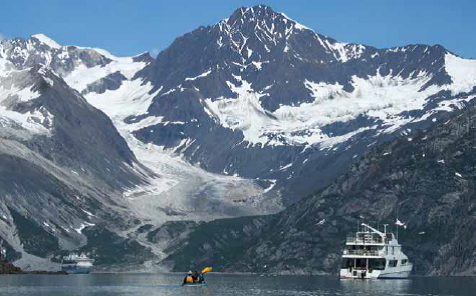
NPS photo
Discussion and Conclusions
This study demonstrated that Kittlitz’s murrelets are temporarily displaced by vessels including cruise ships in Glacier Bay National Park and Preserve. Displacement following vessel events appears to be short-term, because bird density rebounded over the course of a day in the disturbed areas. Therefore, the birds’ displacement by vessels does not result in a persistent loss of their preferred habitat in the park.The study also identified vessel characteristics that are most likely to disturb Kittlitz’s murrelets, and found that different vessel characteristics are attributed to response by breeding versus non-breeding birds. Breeding birds dove from vessels traveling at speeds less than 10 mi/hr, but even slow-moving vessels at far distance from these birds disturbed them and elicited a flight response. It appears that breeding birds are highly sensitive to vessel activity. Non-breeding birds, on the other hand, were most disturbed by large vessels (flew from cruise ships and tour boats), but were little affected by smaller vessels regardless of their speed or approach distance. Non-breeding birds appear less sensitive to the majority of vessel traffic in Glacier Bay.
Flight responses of Kittlitz’s murrelets immediately following a vessel event were shown to incur energy costs; however, the risk of such costs leading to fitness effects is not equivalent for all birds. Chick-rearing is energetically costly, and it is more likely that any additional energy cost to a Kittlitz’s murrelet during chick rearing could have a fitness effect. Whereas, non-breeding birds likely have more flexibility in their energy budgets. Therefore, although the study found that non-breeding birds incur increased energy costs on most days, is it very rare that the increase would be >10%, and likely that non-breeding birds can cope with additional costs <10% on a daily basis. It is still questionable whether they can cope with even small additional costs as a chronic condition, or almost every day.
Breeding birds, on the other hand, were found to incur additional energy costs from their flight responses about a quarter of the time (26% of days). Given the large energy expense these birds already incur to rear their chicks, it is likely that even the relatively low energy increases attributed to their flight responses from vessels, <10% increases, may cause fitness effects for these birds. On top of the costs incurred by flight, they were most likely to dive from vessels and the biological implications of diving for a fish-holding bird may be significant (as shown in Speckman et al. 2004). If their diving leads to a dropped or eaten fish, the lost chick-meal could carry fitness effects to both the adult bird that expends additional energy to catch another fish as well as to its chick if a meal is not delivered.
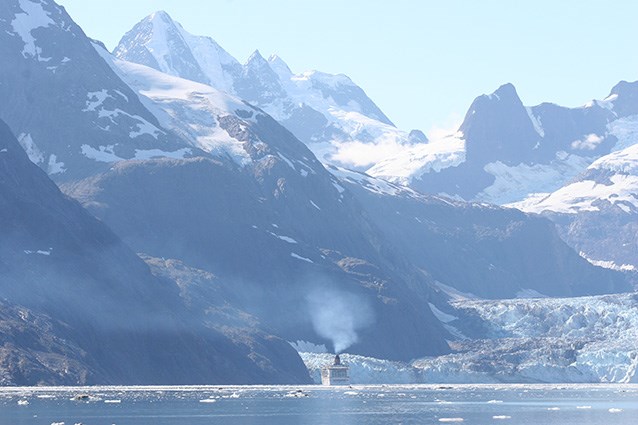
NPS Photo
Management Implications
Breeding Kittlitz’s murrelets are highly sensitive to vessel activity, and susceptible to fitness effects from incurred energetic costs and potential loss of their held fish. The park could consider area restrictions to minimize vessel traffic during the season when Kittlitz’s murrelets rear their chicks (~June 21-July 15 in Glacier Bay, Agness 2006), particularly in known Kittlitz’s murrelet ‘hot spots’ in the bay. Speed restrictions in these areas (<10 mi/hr) may help minimize dive responses, but would not alleviate flight responses, and both types of disturbance carry potential fitness consequences for breeding birds.Although non-breeding birds are less sensitive to vessel activity and less susceptible to fitness effects from incurred energetic costs, management action may still be warranted to reduce their daily energy costs incurred flying from large vessels, since this appears to occur chronically. For example, standard routes for cruise ships could be examined and altered as necessary to minimize their potential to encounter Kittlitz’s murrelets, and standard routes for tour boats could be defined to the same end.
More research on Kittlitz’s murrelets and their interactions with vessels would also help evaluate the utility of vessel management actions. For example, directed survey of Kittlitz’s murrelets from cruise ships traveling along their standard routes would help evaluate the need for route alterations (i.e., are many or few birds encountered?). It would also be beneficial to conduct a tagged bird study, as the data that characterize duration of flight response currently represents minimum estimates (i.e., observations ceased when a bird flew out of direct line-of-sight from the land-based viewing stations), and evaluating time budgets from tagged birds would allow for more comprehensive energetic modeling than has been conducted to date.
References
Agness, A.M., J.F. Piatt, J.C. Ha, and G.R. VanBlaricom. 2008.Effects of Vessel Activity on the Near-shore Ecology of Kittlitz’s Murrelets (Brachyramphus brevirostris) in Glacier Bay, Alaska. Auk 125(2): 346-353.
Agness, A.M., K.N. Marshall, J.F. Piatt, J.C. Ha, and G.R. VanBlaricom.
In prep. Evaluating the energetic impacts of vessel dis-turbance on the Kittlitz’s Murrelet: a risk assessment.
Agness, A.M. 2006.
Effects and impacts of vessel activity on the Kittlitz’s Murrelet in Glacier Bay, Alaska. M.S. thesis, University of Washington. Seattle.
Carter, H.R., and S.G. Sealy. 1987.
Fish-holding behavior of Marbled Murrelets. Wilson Bulletin 99: 289-291.
Day, R.H., K.J. Kuletz, and D.A. Nigro. 1999.
Kittlitz’s Murrelet (Brachyramphus brevirostris). In The Birds of North America, no. 435, edited by A. Poole and F. Gill. Birds of North America. Philadelphia.
Kuletz, K.J., S.W. Stephensen, D.B. Irons, E.A. Labunski, and K.M. Brenneman. 2003.
Changes in distribution and abundance of Kittlitz’s Murrelets (Brachyramphus brevirostris) relative to gla-cial recession in Prince William Sound, Alaska. Marine Ornithology 31:133-140.
Speckman, S.G., J.F. Piatt, and A.M. Springer. 2004.
Small boats disturb fish-holding Marbled Murrelets. Northwestern Naturalist 85: 32-34.
